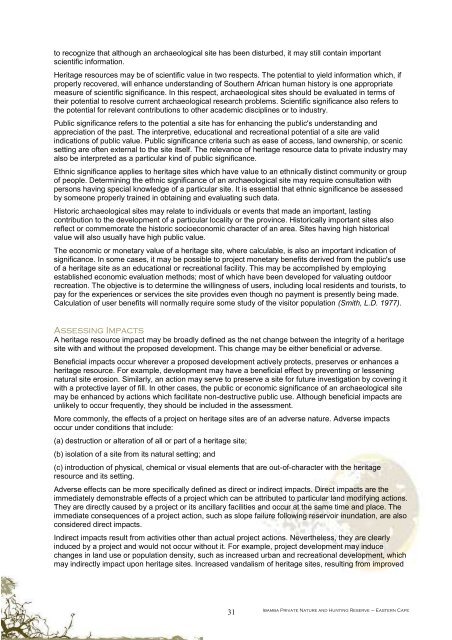Heritage Impact Assessment - SAHRA
Heritage Impact Assessment - SAHRA
Heritage Impact Assessment - SAHRA
Create successful ePaper yourself
Turn your PDF publications into a flip-book with our unique Google optimized e-Paper software.
to recognize that although an archaeological site has been disturbed, it may still contain importantscientific information.<strong>Heritage</strong> resources may be of scientific value in two respects. The potential to yield information which, ifproperly recovered, will enhance understanding of Southern African human history is one appropriatemeasure of scientific significance. In this respect, archaeological sites should be evaluated in terms oftheir potential to resolve current archaeological research problems. Scientific significance also refers tothe potential for relevant contributions to other academic disciplines or to industry.Public significance refers to the potential a site has for enhancing the public's understanding andappreciation of the past. The interpretive, educational and recreational potential of a site are validindications of public value. Public significance criteria such as ease of access, land ownership, or scenicsetting are often external to the site itself. The relevance of heritage resource data to private industry mayalso be interpreted as a particular kind of public significance.Ethnic significance applies to heritage sites which have value to an ethnically distinct community or groupof people. Determining the ethnic significance of an archaeological site may require consultation withpersons having special knowledge of a particular site. It is essential that ethnic significance be assessedby someone properly trained in obtaining and evaluating such data.Historic archaeological sites may relate to individuals or events that made an important, lastingcontribution to the development of a particular locality or the province. Historically important sites alsoreflect or commemorate the historic socioeconomic character of an area. Sites having high historicalvalue will also usually have high public value.The economic or monetary value of a heritage site, where calculable, is also an important indication ofsignificance. In some cases, it may be possible to project monetary benefits derived from the public's useof a heritage site as an educational or recreational facility. This may be accomplished by employingestablished economic evaluation methods; most of which have been developed for valuating outdoorrecreation. The objective is to determine the willingness of users, including local residents and tourists, topay for the experiences or services the site provides even though no payment is presently being made.Calculation of user benefits will normally require some study of the visitor population (Smith, L.D. 1977).Assessing <strong>Impact</strong>sA heritage resource impact may be broadly defined as the net change between the integrity of a heritagesite with and without the proposed development. This change may be either beneficial or adverse.Beneficial impacts occur wherever a proposed development actively protects, preserves or enhances aheritage resource. For example, development may have a beneficial effect by preventing or lesseningnatural site erosion. Similarly, an action may serve to preserve a site for future investigation by covering itwith a protective layer of fill. In other cases, the public or economic significance of an archaeological sitemay be enhanced by actions which facilitate non-destructive public use. Although beneficial impacts areunlikely to occur frequently, they should be included in the assessment.More commonly, the effects of a project on heritage sites are of an adverse nature. Adverse impactsoccur under conditions that include:(a) destruction or alteration of all or part of a heritage site;(b) isolation of a site from its natural setting; and(c) introduction of physical, chemical or visual elements that are out-of-character with the heritageresource and its setting.Adverse effects can be more specifically defined as direct or indirect impacts. Direct impacts are theimmediately demonstrable effects of a project which can be attributed to particular land modifying actions.They are directly caused by a project or its ancillary facilities and occur at the same time and place. Theimmediate consequences of a project action, such as slope failure following reservoir inundation, are alsoconsidered direct impacts.Indirect impacts result from activities other than actual project actions. Nevertheless, they are clearlyinduced by a project and would not occur without it. For example, project development may inducechanges in land use or population density, such as increased urban and recreational development, whichmay indirectly impact upon heritage sites. Increased vandalism of heritage sites, resulting from improved31Ibamba Private Nature and Hunting Reserve – Eastern Cape
















